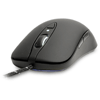- Qualcomm Launches Snapdragon 4 Gen 2 Mobile Platform
- AMD Launches Ryzen PRO 7000 Series Mobile & Desktop Platform
- Intel Launches Sleek Single-Slot Arc Pro A60 Workstation Graphics Card
- NVIDIA Announces Latest Ada Lovelace Additions: GeForce RTX 4060 Ti & RTX 4060
- Maxon Redshift With AMD Radeon GPU Rendering Support Now Available
SteelSeries Sensei [RAW] Gaming Mouse Review

SteelSeries unleashed its Sensei in 2011; one year later, the revamped Sensei [RAW] joins its ever-growing gamer-oriented line. Join us as we see whether or not the newest model’s “less is more” approach is enough to merit its celebrated predecessor’s status as one of the acknowledged masters of the gaming mouse class.
Page 2 – Software
The Sensei [RAW], like all PC mice, works perfectly fine with Windows drivers. However, to take advantage of all of its features, you need to install the SteelSeries Engine software suite.
The download is a mere 36.8MB before installation, so any fears that this is useless bloatware should be allayed. After installation, you can tweak the Sensei [RAW] to your heart’s content.
Engine is divided into four main parts: Button; Settings; Properties; and Statistics. The Button section is like a blueprint, in that it shows you where each button is located. This section also allows you to configure what each button does. If you want a single button to execute a macro or start an application with a single button click, this is where the magic happens. If you want to disable any of the mouse’s buttons for whatever reason, this is where you do it. Finally, if you’re a southpaw and you want your [RAW] to go to left-hand mode, where the left side buttons’ functions are switched over to the right side buttons, it’s all just a click away in this section.
Settings is where the mouse’s sensitivity (measured by SteelSeries in Counts per Inch, analogous to Dots per Inch on other manufacturers’ mice) is configured. As you can see, there are two sliders; the LED Off slider is meant to designate the slower CPI setting, while the LED On slider designates the faster CPI setting. On the mouse itself, you can set the CPI to slow (LED off) or fast (LED on); the sliders configure specifically how slow or fast you want your cursor to move. The extreme degree of granularity of the mouse’s sensitivity adjustment is quite unlike other mice I’ve used in the past.
You can also set the mouse’s Polling Rate and Illumination on the Settings section. The Polling Rate goes in 125Hz steps, from a minimum of 125Hz to a maximum of 1000Hz. Illumination controls the mouse’s LEDs’ behavior. You can set the LEDs’ intensity (Off/Low/Medium/High) and “breathing” effect pulsation (Steady/Slow/Medium/Fast). Just for clarification, “Steady” means “on the whole time.”
The Properties section is where you can define user profiles. Unlike the original Sensei, these user profiles cannot be stored onboard the hardware. That means that you can’t just move your [RAW] to another PC, select your user profile, and start using it exactly the way you use it on the original PC. It’s a hardcore feature, I suppose, but in the real world most people aren’t hardcore (no matter their most elaborate delusions of grandeur). The [RAW], though, allows you to save as many user profiles as you wish. In fact, through Engine, you can theoretically set up a unique user profile tied to specific applications. So, say, you want your Sensei [RAW] to behave in a specific way for Crysis 2 and have it set completely different for Battlefield 3, the Properties section of the Engine software is where it’s done.
Statistics is probably the most superfluous section of Engine. Basically it’s a click-counter. If for whatever reason you want to log how many times you use a particular button (say you’re trying to figure out which buttons would be used the most, in which case you might want to assign your most critical functions to them for maximum efficiency), you can track your click stats in the Statistics section.
Engine is a very intuitive piece of software. Even without the benefit of reading a user’s manual on it, you can figure out how to use it and get the best out of your mouse.
Support our efforts! With ad revenue at an all-time low for written websites, we're relying more than ever on reader support to help us continue putting so much effort into this type of content. You can support us by becoming a Patron, or by using our Amazon shopping affiliate links listed through our articles. Thanks for your support!




![SteelSeries Sensei [RAW] Gaming Mouse SteelSeries Sensei [RAW] Gaming Mouse](/reviews/steelseries/sensei_raw/sensei_raw_06_thumb.jpg)
![SteelSeries Sensei [RAW] Gaming Mouse SteelSeries Sensei [RAW] Gaming Mouse](/reviews/steelseries/sensei_raw/sensei_raw_07_thumb.jpg)
![SteelSeries Sensei [RAW] Gaming Mouse SteelSeries Sensei [RAW] Gaming Mouse](/reviews/steelseries/sensei_raw/sensei_raw_08_thumb.jpg)
![SteelSeries Sensei [RAW] Gaming Mouse SteelSeries Sensei [RAW] Gaming Mouse](/reviews/steelseries/sensei_raw/sensei_raw_09_thumb.jpg)
